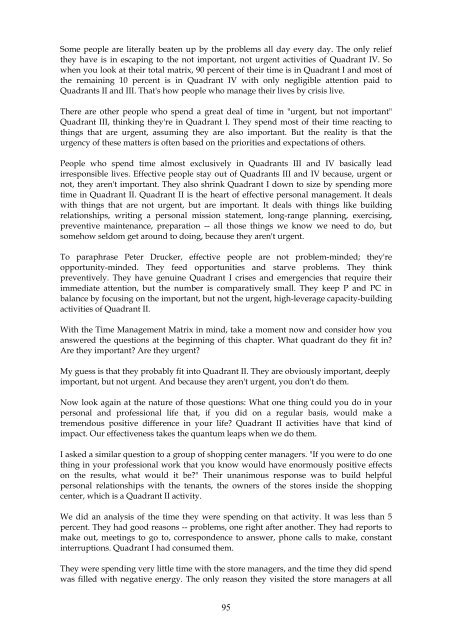Covey - The 7 habits of highly effective people
Create successful ePaper yourself
Turn your PDF publications into a flip-book with our unique Google optimized e-Paper software.
Some <strong>people</strong> are literally beaten up by the problems all day every day. <strong>The</strong> only relief<br />
they have is in escaping to the not important, not urgent activities <strong>of</strong> Quadrant IV. So<br />
when you look at their total matrix, 90 percent <strong>of</strong> their time is in Quadrant I and most <strong>of</strong><br />
the remaining 10 percent is in Quadrant IV with only negligible attention paid to<br />
Quadrants II and III. That's how <strong>people</strong> who manage their lives by crisis live.<br />
<strong>The</strong>re are other <strong>people</strong> who spend a great deal <strong>of</strong> time in "urgent, but not important"<br />
Quadrant III, thinking they're in Quadrant I. <strong>The</strong>y spend most <strong>of</strong> their time reacting to<br />
things that are urgent, assuming they are also important. But the reality is that the<br />
urgency <strong>of</strong> these matters is <strong>of</strong>ten based on the priorities and expectations <strong>of</strong> others.<br />
People who spend time almost exclusively in Quadrants III and IV basically lead<br />
irresponsible lives. Effective <strong>people</strong> stay out <strong>of</strong> Quadrants III and IV because, urgent or<br />
not, they aren't important. <strong>The</strong>y also shrink Quadrant I down to size by spending more<br />
time in Quadrant II. Quadrant II is the heart <strong>of</strong> <strong>effective</strong> personal management. It deals<br />
with things that are not urgent, but are important. It deals with things like building<br />
relationships, writing a personal mission statement, long-range planning, exercising,<br />
preventive maintenance, preparation -- all those things we know we need to do, but<br />
somehow seldom get around to doing, because they aren't urgent.<br />
To paraphrase Peter Drucker, <strong>effective</strong> <strong>people</strong> are not problem-minded; they're<br />
opportunity-minded. <strong>The</strong>y feed opportunities and starve problems. <strong>The</strong>y think<br />
preventively. <strong>The</strong>y have genuine Quadrant I crises and emergencies that require their<br />
immediate attention, but the number is comparatively small. <strong>The</strong>y keep P and PC in<br />
balance by focusing on the important, but not the urgent, high-leverage capacity-building<br />
activities <strong>of</strong> Quadrant II.<br />
With the Time Management Matrix in mind, take a moment now and consider how you<br />
answered the questions at the beginning <strong>of</strong> this chapter. What quadrant do they fit in?<br />
Are they important? Are they urgent?<br />
My guess is that they probably fit into Quadrant II. <strong>The</strong>y are obviously important, deeply<br />
important, but not urgent. And because they aren't urgent, you don't do them.<br />
Now look again at the nature <strong>of</strong> those questions: What one thing could you do in your<br />
personal and pr<strong>of</strong>essional life that, if you did on a regular basis, would make a<br />
tremendous positive difference in your life? Quadrant II activities have that kind <strong>of</strong><br />
impact. Our <strong>effective</strong>ness takes the quantum leaps when we do them.<br />
I asked a similar question to a group <strong>of</strong> shopping center managers. "If you were to do one<br />
thing in your pr<strong>of</strong>essional work that you know would have enormously positive effects<br />
on the results, what would it be?" <strong>The</strong>ir unanimous response was to build helpful<br />
personal relationships with the tenants, the owners <strong>of</strong> the stores inside the shopping<br />
center, which is a Quadrant II activity.<br />
We did an analysis <strong>of</strong> the time they were spending on that activity. It was less than 5<br />
percent. <strong>The</strong>y had good reasons -- problems, one right after another. <strong>The</strong>y had reports to<br />
make out, meetings to go to, correspondence to answer, phone calls to make, constant<br />
interruptions. Quadrant I had consumed them.<br />
<strong>The</strong>y were spending very little time with the store managers, and the time they did spend<br />
was filled with negative energy. <strong>The</strong> only reason they visited the store managers at all<br />
95


